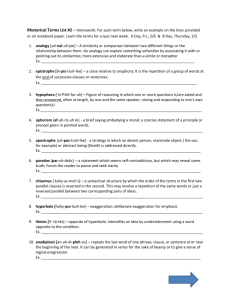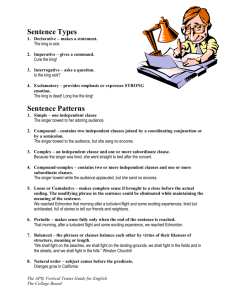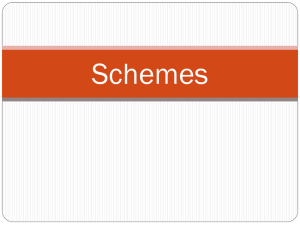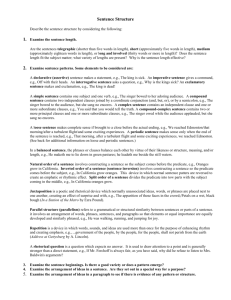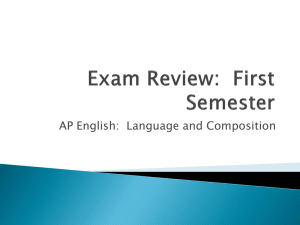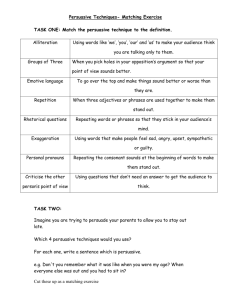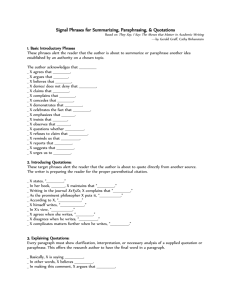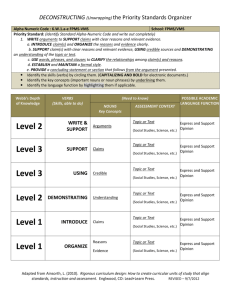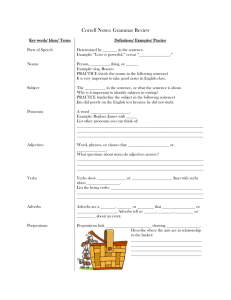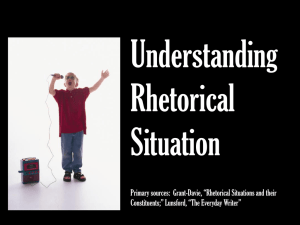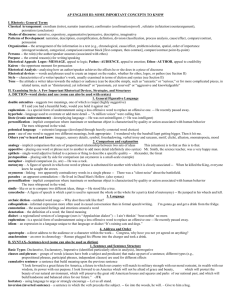Notes on Textual Analysis
advertisement
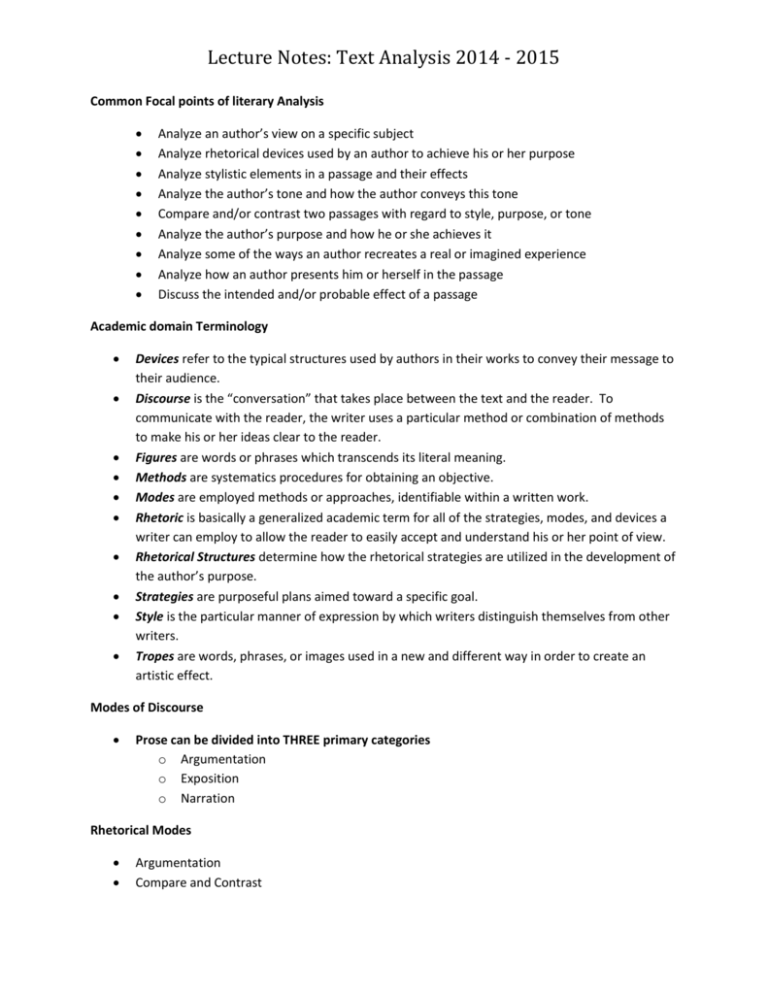
Lecture Notes: Text Analysis 2014 - 2015 Common Focal points of literary Analysis Analyze an author’s view on a specific subject Analyze rhetorical devices used by an author to achieve his or her purpose Analyze stylistic elements in a passage and their effects Analyze the author’s tone and how the author conveys this tone Compare and/or contrast two passages with regard to style, purpose, or tone Analyze the author’s purpose and how he or she achieves it Analyze some of the ways an author recreates a real or imagined experience Analyze how an author presents him or herself in the passage Discuss the intended and/or probable effect of a passage Academic domain Terminology Devices refer to the typical structures used by authors in their works to convey their message to their audience. Discourse is the “conversation” that takes place between the text and the reader. To communicate with the reader, the writer uses a particular method or combination of methods to make his or her ideas clear to the reader. Figures are words or phrases which transcends its literal meaning. Methods are systematics procedures for obtaining an objective. Modes are employed methods or approaches, identifiable within a written work. Rhetoric is basically a generalized academic term for all of the strategies, modes, and devices a writer can employ to allow the reader to easily accept and understand his or her point of view. Rhetorical Structures determine how the rhetorical strategies are utilized in the development of the author’s purpose. Strategies are purposeful plans aimed toward a specific goal. Style is the particular manner of expression by which writers distinguish themselves from other writers. Tropes are words, phrases, or images used in a new and different way in order to create an artistic effect. Modes of Discourse Prose can be divided into THREE primary categories o Argumentation o Exposition o Narration Rhetorical Modes Argumentation Compare and Contrast Lecture Notes: Text Analysis 2014 - 2015 Cause and Effect Definition Description Division and Classification Exemplification Narration Process Analysis Areas of consideration when analyzing for elements of style Audience o Selection of Detail: subjective, objective, type of support o Tone: how the author feels about the topic o Mood: how the audience is supposed to feel about the topic Diction o Formal vs Informal o Literal vs Figurative o Connotative vs Denotative Imagery o Figures: words or phrases which transcend the literal meaning o Tropes: words, phrases, or images used in a new and different way in order to create an artistic effect Purpose o Point of View 1st Person: The writes reveals his/her own actions (I observed…) 2nd Person-The writer directly addresses the reader (If you observed…) 3rd Person: The writer analyzes and evaluates using a passive voice (It can be observed…) Stream-of-consciousness: This is a narrative technique that places the reader in the mind of the writer, no matter how random and spontaneous the writing may be. o Treatment of Subject Matter Fictionalized, Personalized, Customized, Modified, Adapted Organization o Chronology Linear Time Order Sequential: Forward or Backward Before-During-After Past-Present-Future Spatial Urban-Suburban-Rural Lecture Notes: Text Analysis 2014 - 2015 o Modes Local-State-Nation-World Fractured Era, Epoch, Century, Decade, Generation Listing Generalization, then example Argumentation Compare and Contrast Cause and Effect Definition Description Division and Classification Exemplification Narration Process Analysis Syntax o Examine the sentence length. o Are the sentences telegraphic (fewer than five words in length), short (approximately five words in length), medium (approximately eighteen words in length), or long and involved (thirty words or more in length)? o Does the sentence length fit the subject matter; what variety of lengths are present? o Why is the sentence length effective? o How does the structure fit the subject matter? o Examine sentence patterns. o Functional o A declarative (assertive) sentence makes a statement, e.g., The king is sick. An imperative sentence gives a command, e.g., Off with their heads. An interrogative sentence asks a question, e.g., Why is the king sick? An exclamatory sentence makes and exclamation, e.g., The king is dead! o Grammatical o A simple sentence contains one subject and one verb, e.g., The singer bowed to her adoring audience. A compound sentence contains two independent clauses joined by a coordinate conjunction (and, but, or), or by a semicolon, e.g., The singer bowed to the audience, but she sang no encores. A complex sentence contains an independent clause and one or more subordinate clauses, e.g., You said that you would tell the truth. A compound-complex sentence contains two or more principal clauses and one or more subordinate clauses, e.g., The singer owed while the audience applauded, but she sang no encores. o Rhetorical Lecture Notes: Text Analysis 2014 - 2015 o o o o o o A loose sentence is one in which the independent clause comes at the beginning and makes complete sense if brought to a close before the actual ending, e.g., We reached Edmonton/that morning/after a turbulent flight/and some exciting experiences. A periodic sentence makes sense only when the end of the sentence is reached because the independent clause comes at the end, e.g., That morning, after a turbulent flight and some exciting experiences, we reached Edmonton. In a balanced sentence, the phrases or clauses balance each other by virtue of their likeness or structure, meaning, and/or length, e.g., He maketh me to lie down in green pastures; he leadeth me beside the still waters. Natural order of a sentence involves constructing a sentence so the subject comes before the predicate, e.g., Oranges grow in California. Inverted order of a sentence (sentence inversion) involves constructing a sentence so the predicate comes before the subject, e.g., In California grow oranges. This is a device in which normal sentence patterns are reversed to create an emphatic or rhythmic effect. Split order of a sentence divides the predicate into tow parts with the subject coming in the middle, e.g., In California oranges grow. Juxtaposition is a poetic and rhetorical device which normally unassociated ideas, words, or phrases are placed next to one another, creating an effect of surprise and with, e.g., The apparition of those faces in the crowd;/Petals on a wet, black bough (In a Station of the Metro by Ezra Pound). Parallel structure (parallelism) refers to a grammatical or structural similarity between sentences or parts of a sentence. it involves an arrangement of words, phrases, sentences, and paragraphs so that elements or equal importance are equally developed and similarly phrased, e.g., He was walking, running, and jumping for joy. Antithesis-Contrasting words, phrases, or clauses are placed next to each other.
